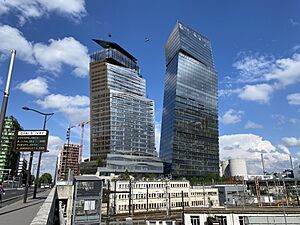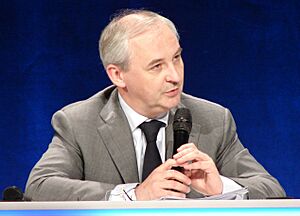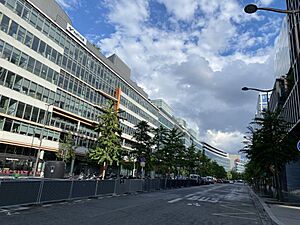Groupe BPCE facts for kids

Tours Duo in Paris, headquarters of Groupe BPCE as of 2022
|
|
| Private. Cooperative | |
| Industry | Financial services |
| Founded | 19 December 2006 31 July 2009 as Groupe BPCE |
| Headquarters |
Paris
,
France
|
|
Key people
|
Nicolas Namias, CEO of BPCE; Stephanie Paix, CEO of Natixis |
| Products | Banking and insurance |
| Revenue | |
|
Operating income
|
|
| AUM | |
| Total assets | |
| Total equity | |
|
Number of employees
|
100,000 (2022) |
Groupe BPCE (for Banque Populaire Caisse d'Epargne) is a major French banking group formed by the 2009 merger of two major retail banking groups, Groupe Caisse d'Épargne and Groupe Banque Populaire. As of 2021, it was France's fourth largest bank, the seventh largest in Europe, and the nineteenth in the world by total assets. It has more than 8,200 branches nationwide under their respective brand names serving nearly 150 million customers. Its wholesale banking subsidiary Natixis, previously a separately listed company, was delisted and came under full ownership of Groupe BPCE in 2021.
BPCE has been designated as a Significant Institution since the entry into force of European Banking Supervision in late 2014, and as a consequence is directly supervised by the European Central Bank. It is also designated as a global systemically important bank (G-SIB) by the Financial Stability Board.
History
In 2008 and early 2009, the French state provided around 7 billion euros of financial support to the group formed by Caisse d'Épargne, Banque Populaire and their joint venture Natixis. François Pérol, a senior aide to President Nicolas Sarkozy, led the decision-making on the group's restructuring. The entity resulting from the merger of CNCE and BFBP, named BPCE, was formed on 2009-07-31. That same day, Pérol became its CEO while Philippe Dupont, previously the chairman of Groupe Banque Populaire, became non-executive chairman of BPCE.
In 2014, BPCE had Coface listed through an initial public offering, and subsequently reduced its equity stake. As of March 2021, BPCE retained residual ownership of 12.7 percent of Coface's capital.
In July 2016, BPCE announced the purchase of Fidor Bank, a Fintech challenger bank, operating in the UK and Germany, but in November 2018 considered selling it again.
In 2018–2019, BPCE fully integrated the former Crédit Foncier de France's activities into its other operations and terminated the use of the Crédit Foncier brand.In June–July 2021, it acquired all shares of Natixis that it did not previously own, and completed the entity's delisting on 2021-07-31.
Structure and operations
Despite the 2009 merger, the two networks of local banks, Caisse d'Épargne and Banque Populaire, continue to operate under separate and to an extent competing brands. BPCE is fully owned by local savings banks and popular banks, which in turn are legally owned by their customers as cooperative members.
BPCE provides various deposit and loan products to small and medium enterprises, craftspeople, franchisees, and franchisers; savings collection and management, credit, payment, and wealth management services; and real estate financing and corporate banking services. The company also offers bancassurance products, including life assurance and pensions that comprise automobile and home insurance, legal protection, the guarantee of life accidents, the supplementary health care insurance, welfare professionals and the collective retirement pensions and health, as well as credit insurance and guarantees to individuals, professionals, real estate professionals, and businesses.
Leadership
Groupe BPCE has had three chief executives (French: président du directoire) so far:
- François Pérol (July 2009 - May 2018)
- Laurent Mignon (June 2018 – December 2022)
- Nicolas Namias (December 2022 – present)
See also
 In Spanish: Groupe BPCE para niños
In Spanish: Groupe BPCE para niños
- BNP Paribas
- Société Générale
- Crédit Agricole
- Crédit Mutuel



